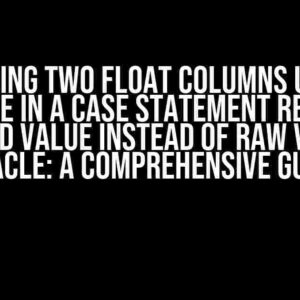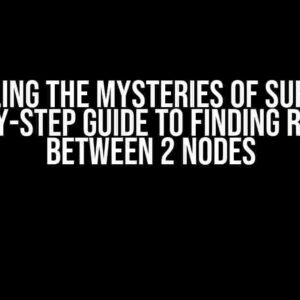Cloning a Pluggable Database (PDB) in Oracle Cloud Infrastructure (OCI) can be a daunting task, especially when faced with pesky issues that seem to appear out of nowhere. But fear not, dear Oracle enthusiasts! In this article, we’ll dive deep into the world of OCI cloning PDB issues, exploring the most common problems, their causes, and – most importantly – how to troubleshoot and resolve them. Buckle up, because we’re about to embark on a journey to conquer these issues once and for all!
Understanding ORACLE OCI Cloning PDB
Before we dive into the nitty-gritty of cloning PDB issues, it’s essential to understand the basics of OCI cloning PDB. Oracle’s OCI allows you to create a clone of a PDB, which is a self-contained database that can be easily managed and maintained. Cloning a PDB enables you to create a duplicate of the original database, making it an ideal solution for testing, development, and production environments.
Why Clone a PDB?
So, why would you want to clone a PDB in the first place? Here are just a few compelling reasons:
- Testing and development: Cloning a PDB allows you to create a duplicate of your production database, enabling you to test and develop new applications without affecting the original database.
- Data recovery: In the event of a disaster, cloning a PDB can help you recover your data quickly and efficiently.
- Production environment testing: Cloning a PDB enables you to test your production environment without affecting the actual production database.
Common ORACLE OCI Cloning PDB Issues
Now that we’ve covered the basics, let’s explore some of the most common issues you may encounter when cloning a PDB in OCI:
Issue 1: Insufficient Disk Space
The most common issue when cloning a PDB is running out of disk space. This can occur if the target database doesn’t have enough free space to accommodate the cloned PDB.
ORA-01236: Cannot create database file ' filename'DBA-12438: File cannot be created
To resolve this issue, ensure that the target database has sufficient free space to accommodate the cloned PDB. You can do this by:
- Checking the available disk space using the following command:
SELECT * FROM dba_free_space; - Increasing the disk space by adding more storage to the target database.
Issue 2: Invalid or Expired TDE Wallet
If the TDE wallet is invalid or expired, you may encounter issues when cloning a PDB. This can occur if the wallet is not properly configured or has expired.
ORA-28374: TDE wallet is not open
To resolve this issue, ensure that the TDE wallet is properly configured and open. You can do this by:
- Verifying the TDE wallet status using the following command:
SELECT * FROM v$encryption_wallet; - Opening the TDE wallet using the following command:
ALTER SYSTEM SET ENCRYPTION WALLET OPEN;
Issue 3: Incompatible Database Versions
If the source and target databases have different versions, you may encounter issues when cloning a PDB. This can occur if the target database is not compatible with the source database version.
ORA-00604: error occurred at recursive SQL level 1
To resolve this issue, ensure that the source and target databases have compatible versions. You can do this by:
- Verifying the database versions using the following command:
SELECT * FROM v$version; - Upgrading the target database to a compatible version.
Troubleshooting ORACLE OCI Cloning PDB Issues
In addition to the common issues mentioned above, there are several other factors to consider when troubleshooting OCI cloning PDB issues. Here are some general tips to help you troubleshoot and resolve issues:
- Check the alert log: The alert log is your best friend when it comes to troubleshooting OCI cloning PDB issues. Check the log for any error messages or warnings that may indicate the cause of the issue.
- Verify the clone configuration: Ensure that the clone configuration is correct, including the source and target database connections, storage, and networking.
- Check the database status: Verify that the source and target databases are online and available.
- Verify the TDE wallet status: Ensure that the TDE wallet is properly configured and open.
- Check the disk space: Verify that the target database has sufficient free space to accommodate the cloned PDB.
Best Practices for ORACLE OCI Cloning PDB
To avoid common issues and ensure a successful PDB clone, follow these best practices:
| Best Practice | Description |
|---|---|
| Verify the source and target database versions | Ensure that the source and target databases have compatible versions to avoid compatibility issues. |
| Verify the TDE wallet status | Ensure that the TDE wallet is properly configured and open to avoid encryption issues. |
| Check the available disk space | Verify that the target database has sufficient free space to accommodate the cloned PDB. |
| Test the clone configuration | Test the clone configuration to ensure that it is correct and functional. |
| Monitor the clone process | Monitor the clone process to identify any issues and take corrective action. |
Conclusion
Cloning a PDB in Oracle Cloud Infrastructure (OCI) can be a complex process, but by understanding the common issues and following best practices, you can overcome these challenges and ensure a successful clone. Remember to troubleshoot issues systematically, checking the alert log, verifying the clone configuration, and ensuring that the source and target databases have compatible versions. With this comprehensive guide, you’ll be well on your way to conquering ORACLE OCI cloning PDB issues and enjoying the benefits of a successfully cloned PDB.
By following the tips and best practices outlined in this article, you'll be able to overcome common ORACLE OCI cloning PDB issues and ensure a successful clone. Remember to stay vigilant, monitoring the clone process and troubleshooting issues as they arise. With persistence and patience, you'll be able to conquer even the most daunting OCI cloning PDB issues!
Here are 5 Questions and Answers about “ORACLE OCI cloning PDB issues” in a creative voice and tone:
Frequently Asked Questions
We’ve got the answers to your burning questions about Oracle OCI cloning PDB issues!
Why does my Oracle OCI cloning of a PDB take so long?
Ah, patience is a virtue, my friend! The cloning process can take some time due to factors like network speed, database size, and the number of resources available. Make sure you’ve got a stable connection and sufficient resources allocated. Also, consider cloning a read-only copy of the PDB or using Oracle’s Auto-Tune feature to speed things up!
How do I troubleshoot connectivity issues during Oracle OCI PDB cloning?
Don’t panic! Check your OCI console for any error messages or warnings. Verify that your network settings are correct, and the necessary ports are open. Ensure that your database is not in a restricted mode and that the Pluggable Database (PDB) is not in a “NO ACCESS” state. If all else fails, try restarting the cloning process or reach out to Oracle Support for further assistance!
Can I clone a PDB from one Oracle OCI region to another?
Absolutely! You can clone a PDB across Oracle OCI regions using the “Cross-Region Cloning” feature. This allows you to create a copy of your PDB in a different region, perfect for disaster recovery, dev/test environments, or migrating to a new region. Just make sure you’ve got the necessary permissions and that your database is compatible with the target region!
What happens to my PDB after cloning in Oracle OCI?
After cloning, your new PDB will be an exact copy of the original, including all data, schema, and settings. The cloned PDB will have its own unique ID and can be managed independently from the source PDB. You can then use this new PDB for testing, development, or even as a production database. Just remember to update any dependencies, like connections and credentials, to point to the new PDB!
Are there any best practices for Oracle OCI PDB cloning?
You bet! To avoid any headaches, make sure you’ve got a solid understanding of your database architecture and requirements. Plan ahead, and consider cloning a read-only copy of your PDB first to test the process. Use Oracle’s recommended cloning methods, like the “DBCLI” tool, and follow best practices for naming conventions, storage settings, and security configuration. And, of course, always back up your data before cloning – you never know when you might need it!
Let me know if you need anything else!



